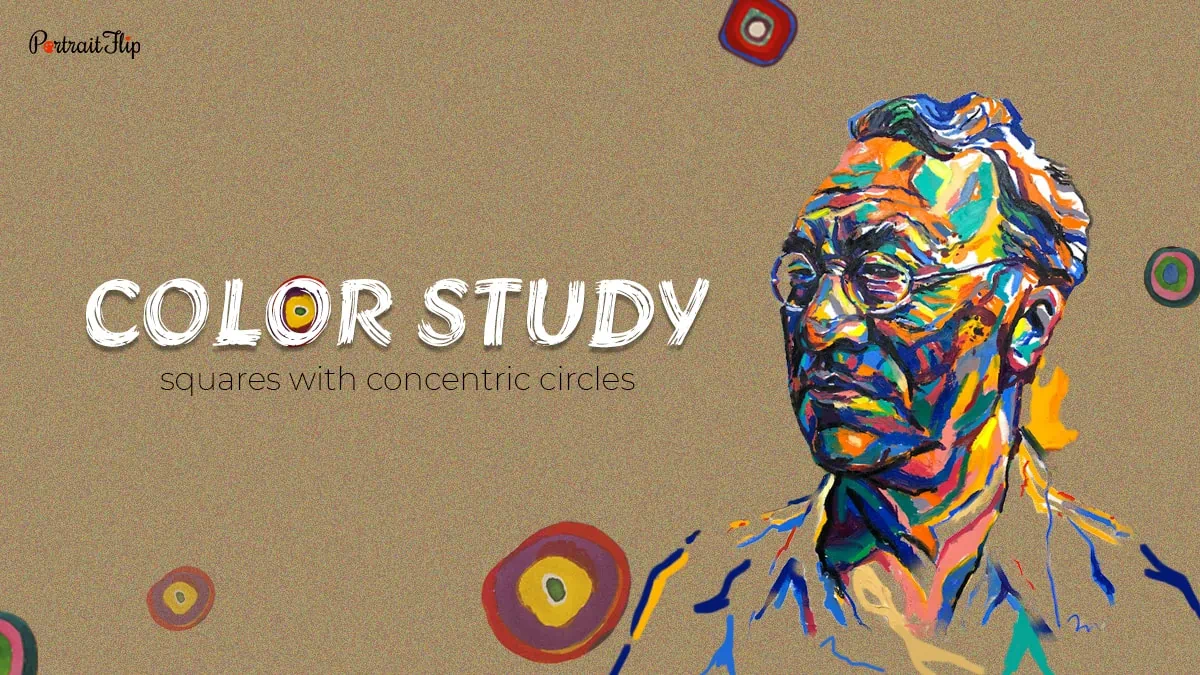You have seen “Color Study: Squares With Concentric Circles,” an artwork that portrays circles in squares.
But have you ever evaluated a painting that revolves around art with circles?
The work that captivates viewers often holds the deepest and most interesting stories.
Want to know why Kandinsky drew these abstract art circles?
Well, if you are fond of groovy lines, a colorful canvas, and shapes that are undefined, then you must read this blog (Study Circle Art) till the end.
It’s one of the most talked-about paintings by Kandinsky that speaks the language of colors, or perhaps I should say it illuminates the sounds of color.
Color Study: Squares with Concentric Circles is one such art that is beyond one’s knowledge!
So, ignite your curiosity and study the analysis of “Color Study: Squares With Concentric Circles” in no time!
How about we start with the Kandinsky artist who has given us this masterpiece?
Table of contents
1. Know The Artist: Who was Kandinsky?
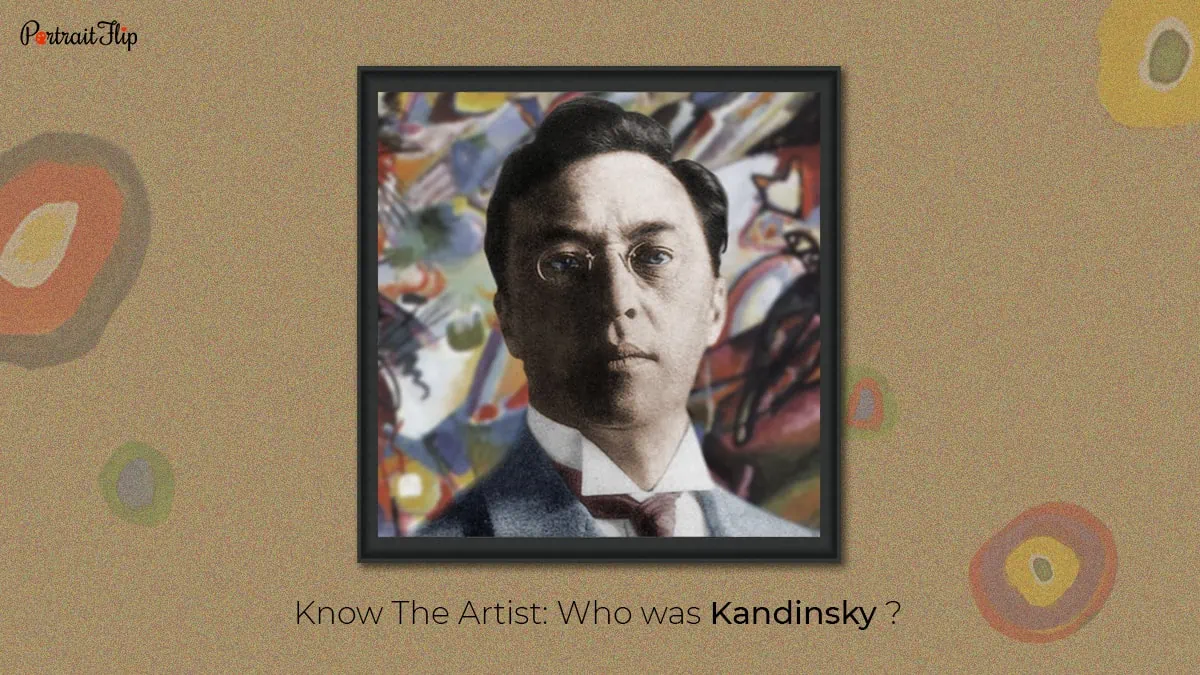
Before we dive into the artist, there is one question for you: Can you hear the sounds of colors?
Yes, you read it right, HEAR!
Wassily Kandinsky, a famous abstract painter and expressionist, claimed that he could hear the sounds of the colors.
He was diagnosed with synesthesia and discovered that he could hear colors, sense the sounds around him, and taste shapes.
But if I told you that Kandinsky was not into the arts in the first place, would you believe me?
It’s true! Kandinsky started his career as a professor of law and economics at Moscow University.
He never thought that getting into art could be one of his turning points until he hit his late 30s.
He easily understood that he was born to study colors, but life has other plans for him.
A painter-to-be was not able to get into the art school, which led to Kandinsky’s experiments.
The artwork that inspired him the most was “Haystacks,” one of Claude Monet’s paintings.
It eventually gave birth to his artful mind and made him one of the founding fathers of abstract art.
Paintings by Wassily Kandinsky made use of colors, which give light and a sense of being conscious.
This could be witnessed in the formation of Der Blaue Reiter, or the Blue Rider, a group that would reflect emotions through emphasizing colors.
The experiments led to the creation of “Color Study: Squares With Concentric Circles,” which is a brilliant example of colors in squares.
With his masterful use of art and technique, Kandinsky symbolizes the perfect bond between shapes and forms.
Who doesn’t want an original Kandinsky mounted on their wall?
With Wassily Kandinsky replicas, it is now easy and affordable to get one of the original copies delivered to your doorstep!
Let’s study the famous circle paintings, which provide meaning to the artist’s mind.
2. Explore The Art
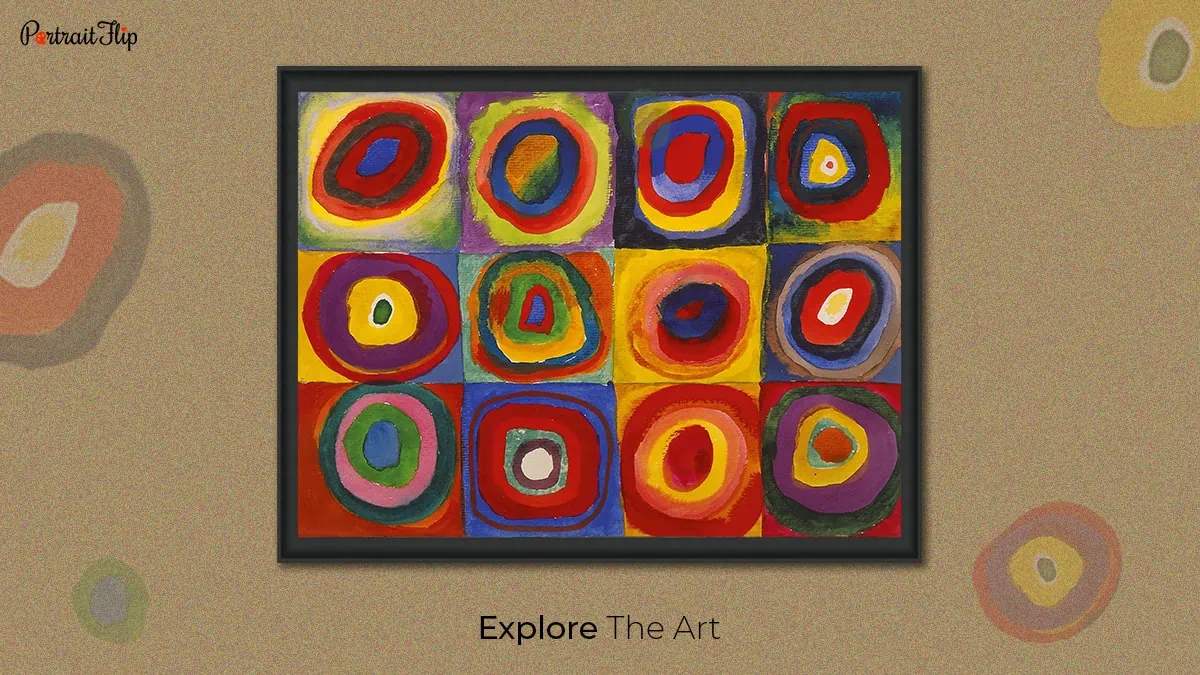
What thoughts did you have when you first saw “Color Study: Squares With Concentric Circles?”
Is it an experimental work, or Kandinsky art, that is trying to introduce a new art form to the world?
This famous abstract painting is an example of Kandinsky’s inspiration through the sheer intensity and influence of music composition through art.
He believed that music and art must go hand-in-hand with the theory that painting could be like music.
The creation of “Color Study: Squares With Concentric Circles” provided his belief with meaning.
This painting of 12 squares with concentric circles is a true abstraction of art.
To build a perfect balance between the colors, this Kandinsky painting juxtaposes not only different shapes but also the contrast of vibrant colors and their relationship.
Kandinsky always described the colors as human emotions that generate a feeling among the people.
If you give the color a closer look, you’ll get a sense of warmth and coolness, depending on the hues.
His complementary use of different shades, such as blue and orange or blue and red, develops a connection between each other.
You’ll never get the same feeling when you observe red with yellow and red with blue.
The intensity and vibrancy of each pigment vary from one circle to another.
The idea was to explore the art and observe how each color establishes a relationship with each other.
How about knowing the art in a more vast form and the type it belongs to?
3. What is Abstract Art?

Have you seen abstract art before? What questions were raised when your eyes first fell on this type of art?
Weird, or who paints such art, or does the painting even carry a meaning?
Abstract art has been in culture since the 19th century and does not reflect any characters or story behind it; instead, it portrays shapes, lines, and hue intensity that create a different art all together.
A painting that does not attempt to create an actual depiction of visuals is something that captivates the viewer’s attention.
Kandinksy himself said in one of his quotes that “objects damage pictures!”
The word abstract means to remove or extract something from another, which draws on the fundamental elements of paintings such as lines, shapes, and colors.
Each element reflects its own significance, which is the beauty of abstract art.
The term is also used to describe art that is not inspirational.
As mentioned earlier, abstract art is not representational and could be created with real objects or no objects at all.
As a non-representational artwork, it allows the artist to paint based on their experience or the emotions they have in their heart.
There are numerous famous artists who practice this type of art and express their feelings through color.
Apart from Kandinsky, the pattern could be witnessed through Jackson Pollock’s paintings, which are the purest form of abstract art.
The abstract art provided us with an idea of what “Color Study: Squares With Concentric Circles” was all about.
Now let’s acknowledge the meaning that the Kandinsky art circles want to portray.
Also read: Rothko’s Entrance to Subway painting (a not-so-abstract art)
4. Meaning Behind The Painting
A painting that is drawn randomly without any definite shapes or colors explains what?
Kandinsky uses watercolors made with gouache and crayons to explain his feelings on paper.
This brought light to Kandinsky’s experiments to establish a relationship between colors.
He came up with the idea that his paintings have a dual effect. At first glance, the audience will be drawn by the physical impact aroused by the colors.
This way, it evokes a physical reaction among the people with the ability to hear and see the painting.
The main agenda of “Color Study: Squares With Concentric Circles” was to find out which colors blended together and which stood out in the frame.
With the color format of warm reds and yellows, icelandic blues, and forest greens, Kandinsky examined the overlapping of the shades by placing them in squares.
The square shape begins to radiate and transform into a circular shape with each overlap of hues and textures.
The other effect produced by Kandinsky was “soul vibration.”
Here, the artwork itself was able to move past the physical stage and produce an internal connection within the viewers.
But as with other famous artists, Kandinsky must also have had some inspiration before he put his hands to creating such a masterpiece, right?
5. Kandinsky Inspiration
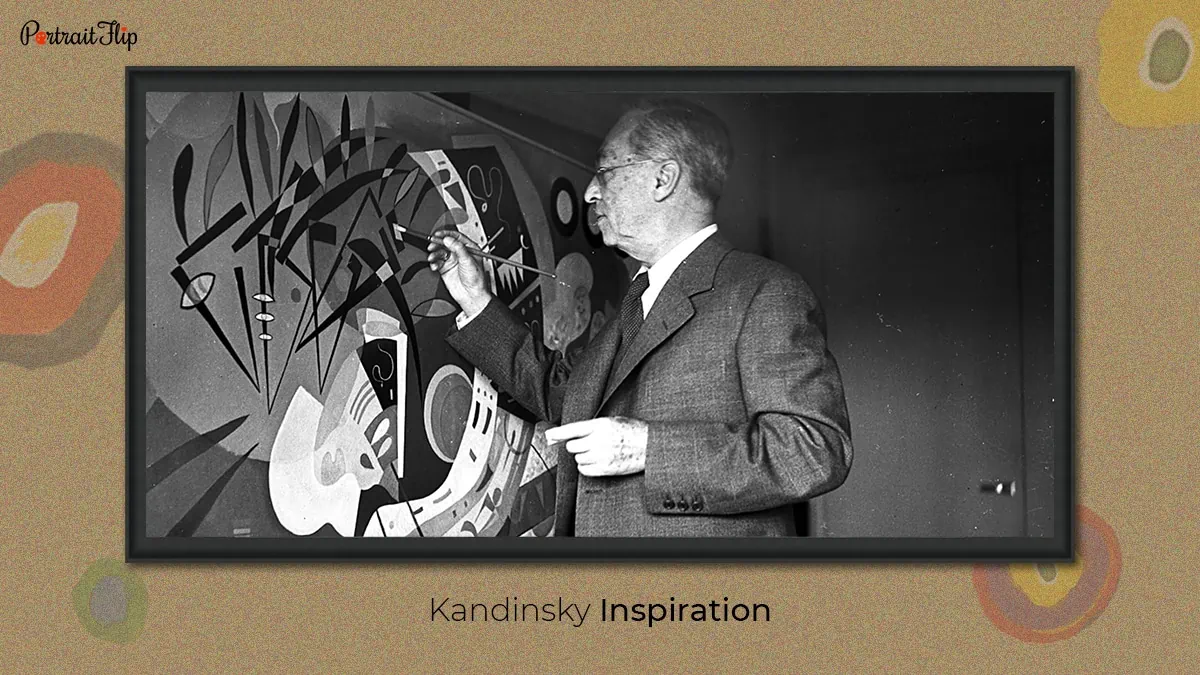
What inspired Kandinsky the most to paint a study of colors?
We already know that his inspirations were composers and philosophers.
If you look at Kandinsky’s paintings, they are mostly landscapes.
Those arts were heavily influenced by Post-Impressionist artists.
Kandinsky also used different art styles, such as Fauvism and Pointillism.
When he painted “Color Study: Squares With Concentric Circles,” the belief was that the circles were symbolic representations of the abstract form.
He wanted to generate a relationship between colors when they came into contact with each other.
There was one theory about the circle art that the shades eventually make the human soul vibrate and are a powerful tool to influence their physical organism.
A thought that is so powerful gives an idea about what exactly Kandinsky wanted to portray through his famous circle paintings.
Was he trying to hypnotize people with the color scheme?
Maybe!
Kandinsky’s exploration took a turn into more abstract painting due to people’s obsession with materialism.
This also inspired him to escape into his own world and give art a new definition.
Kandinsky even wrote about the meaning of color in one of his books.
If you are into hues or a bibliophile, read “Concerning the Spiritual in Art,” which will leave you with a new perspective.
As mentioned earlier about Kandinsky hearing the sounds of colors, do you want to know which color represents which sound? Let me enlighten you on this topic.
You can also read:
Composition 8 by Wassily Kandinsky, or The Storm on The Sea of Galilee
6. Sound Of Colors
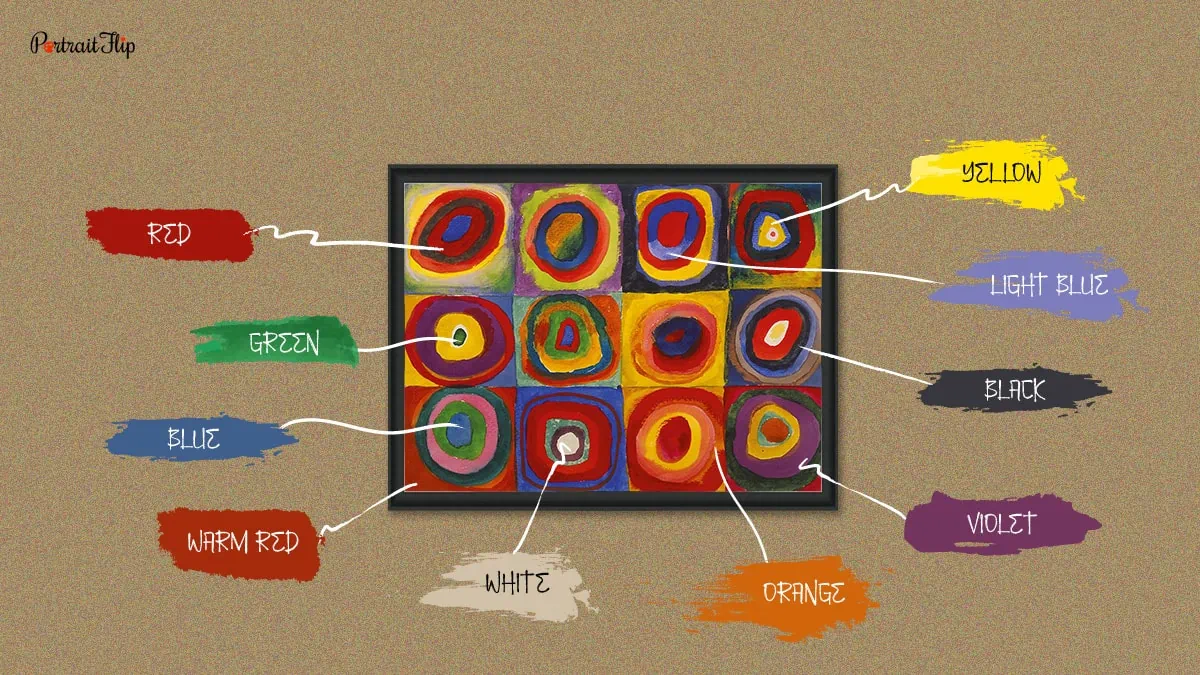
Each color has a feeling, a sensation, and a sound.
Kandinsky, as an artist, wanted to find the means of communication through the perception of shades.
He develops a series of images that pair up to create an authentic and energetic visual.
Kandinsky’s concentric circles illuminate different resonances and blend with the characteristics that each color carries.
What are the rings that give every color a unique view?
Red in Color Study: Squares With Concentric Circles
The color red has two forms in the painting. One is warm red, and the other is cool red.
The light, warm red represents the high notes of trumpets, which are strong, intense, and powerful.
It reflects a bizarrely disturbing sound with high density.
On the other hand, the cool red gives out the sad middle tones of the cello, which are easy and simple.
Now you may have started to feel this abstract painting by Kandinsky in your ears, right?
Green in Color Study: Squares With Concentric Circles
The spiritual sound of this color gives out the placid middle notes of violin resonance. Placed in the center, outer, and middle of the circles, they compose a smooth sound in the painting.
Kandinsky knew what he was experimenting with and didn’t hesitate to give the color a specific name or sound.
Blue in Color Study: Squares With Concentric Circles
A heavenly color that represents what? This shade is also derived in two forms. One being in light form and the other in dark.
The light form gives out a simple, easy, and effortless flute sound that is soothing for both eyes as well as the ears.
The dark color scheme portrays a thunderous view with a loud roar, rumble, and growl.
If you observe, he has maintained the perfect amount of balance between the hues.
Each shade illuminates an individual sense in the eyes of humans, giving new meaning to what are called concentric circles.
White in Color Study: Squares With Concentric Circles
As an artist, you must know when and how to take intervals in order to carry forward the other note. Kandinsky, as a painter, chose white as his color in his famous paintings of squares.
White here represents the pause in music that breaks the melody. It gives the Abstract art by Wassily Kandinsky a mood, which is a hidden key point of the painting.
In other words, it gives rest to the audience from the view before they connect to another shade.
Wassily Kandinsky was a mastermind, and when he said that he was influenced by music and composers, he literally meant each form.
Orange in Color Study: Squares With Concentric Circles
Have you heard about the term “Angelus?”
It is basically the term that means call to prayer and goodwill for everyone.
Kandinsky made the shade of orange represent the angelus sound of the old violin that brings the Catholic into the sound of nature.
It is also believed that the color orange comes from the bond between red and yellow.
Violet in Color Study: Squares With Concentric Circles
You are now learning the language of Kandinsky. Can you guess the sound of this color?
Basically, Kandinsky’s concentric circles are full of mysteries and new inventions.
Violet resonates in cor anglais, which is also known as English horn, including the deep notes of woodwind instruments.
This shade in Kandinsky circles gives out a chime of warm, intense, and passionate tones.
But let me tell you something about this shade. The birth of the color violet was a mixture of two shades: blue and red.
As mentioned earlier, Kandinsky was into experimenting and learning about the connection between each color.
Yellow in Color Study: Squares With Concentric Circles
This shade represents the high notes of the violin and cello. It basically gives the viewers a feeling of being uplifting, happy, and mellow.
There is one more shade that was created with the connection of two colors, red and white.
Can you guess what the shade would be?
It was the color pink, which is to the left of the down square.
Black in Color Study: Squares With Concentric Circles
What could the shade black resonate with? Dark, gloomy, dingy?
Somewhere, you are right. The color black illuminates a final pause.
According to Kandinsky’s point of view, it seems like the dawn of another world. The color of least harmony and a dead silence, which gives the art an end note.
Don’t these sounds add a feeling of enthusiasm to the painting? It literally makes anyone want to own one.
Then what are you waiting for? Get this famous abstract painting that will add color to your walls.
Click on the link below and start your process!
7. Its Appeal Today
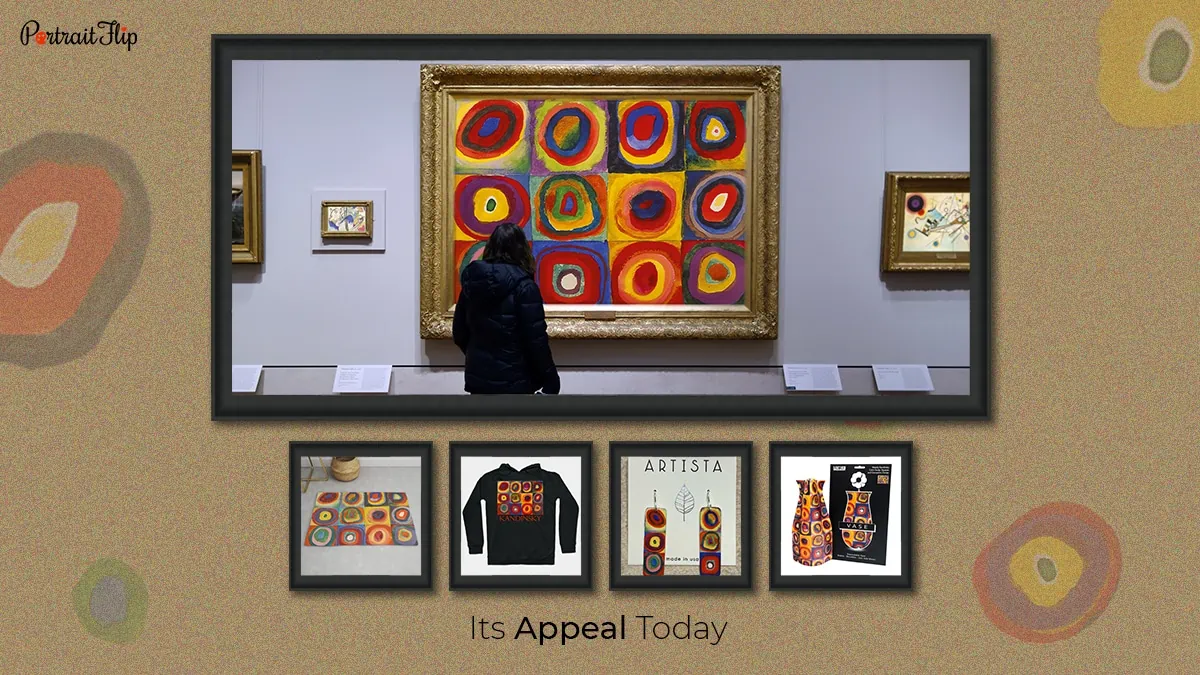
Where is Color Study: Squares with Concentric Circles? The painting is situated in the City Gallery in Lenbachhous, Munich, Germany.
It is one of the most reproduced artworks among all the paintings by Kandinsky.
When you look at the picture above, you’ll notice how appealing this painting is to people.
Making the art of Kandinsky appear in the best way possible, the world created their own masterpieces, keeping color study their primary objective.
Whether it is fashion or decor, painting is incorporated into every culture.
As mentioned by Kandinsky, “Everything starts from a dot,” which portrays a perfect meaning to how impactful his one painting became.
Suggested Read: Composition VII by Wassily Kandinsky
8. Personal Insight
When it comes to artwork, a person surely has some personal insights.
What if you entered a gallery and saw Color Study: Squares with Concentric Circles? What would be your first thought?
Colorful? Circles with vibrant shades? Watercolors on paper?
From my perspective, this painting by Kandinsky was surely something one could have created while experimenting with colors.
Living in the 21st century, the painting could give me a feeling of pride. A symbol that represents the pride of people and their community.
Or doesn’t it feel like the painting is hypnotizing?
If I look at the artwork for a longer period of time, it surely gives me a feeling of hypnotism, as if the painter wants the viewers to forget everything and just dive deeper into the colorful art.
Circles in circles!
These three were my personal insights into what I felt after the first glance at the painting.
Now you know my vision for the painting “Color Study: Squares With Concentric Circles.”
You must also have had your first thoughts about the painting, right?
Share your insights at – Arpita Parashar that would be our little secret!
Hi From The Writer
How did you find the blog, “Color Study: Squares With Concentric Circles?”
Informative, knowledgeable, interesting?
Give your feedback via comments, which are more valuable for us.
Also, you can follow us on Instagram, YouTube, and Pinterest for some amazing handmade paintings and content.
Till then, adios amigos!
FAQs
Color Study by Kandinsky is also known as Farbstudie Quadrate.
The painting by Kandinsky measures 23,9 cm by 31,5 cm.
Kandinsky loved playing around with circles in art. He has a belief that it creates qualities and maintains balance in his artwork.
The meaning behind the painting is that its circles act as a central point in the artwork within each square unit.



